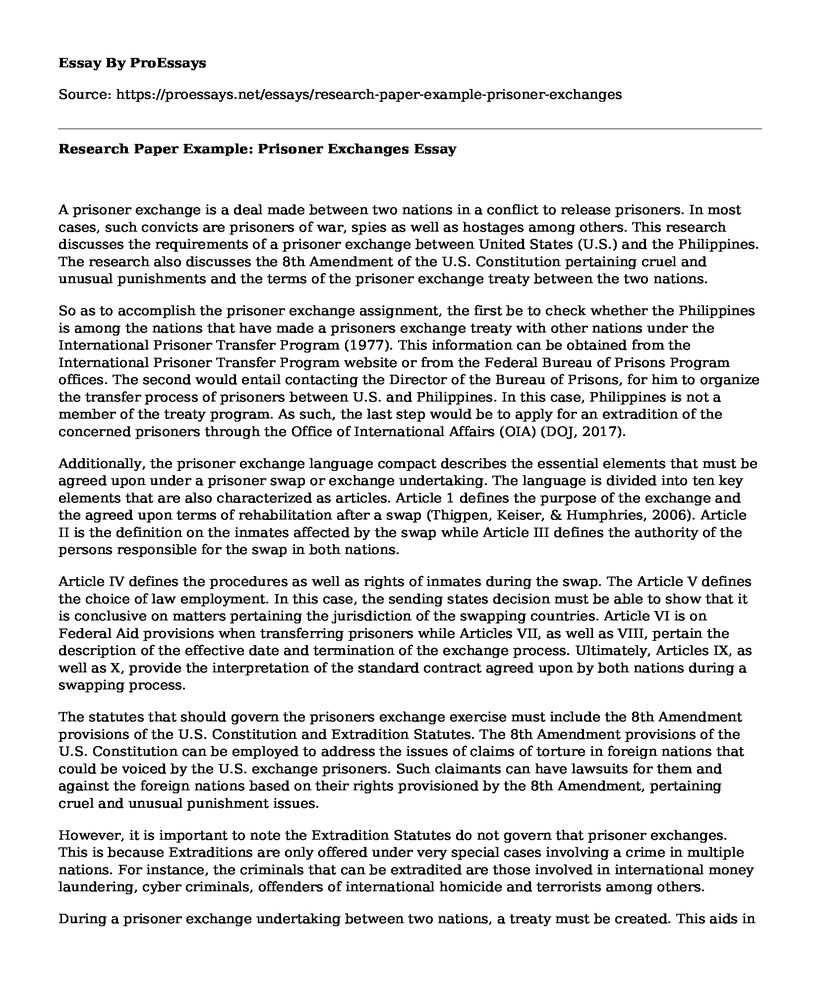A prisoner exchange is a deal made between two nations in a conflict to release prisoners. In most cases, such convicts are prisoners of war, spies as well as hostages among others. This research discusses the requirements of a prisoner exchange between United States (U.S.) and the Philippines. The research also discusses the 8th Amendment of the U.S. Constitution pertaining cruel and unusual punishments and the terms of the prisoner exchange treaty between the two nations.
So as to accomplish the prisoner exchange assignment, the first be to check whether the Philippines is among the nations that have made a prisoners exchange treaty with other nations under the International Prisoner Transfer Program (1977). This information can be obtained from the International Prisoner Transfer Program website or from the Federal Bureau of Prisons Program offices. The second would entail contacting the Director of the Bureau of Prisons, for him to organize the transfer process of prisoners between U.S. and Philippines. In this case, Philippines is not a member of the treaty program. As such, the last step would be to apply for an extradition of the concerned prisoners through the Office of International Affairs (OIA) (DOJ, 2017).
Additionally, the prisoner exchange language compact describes the essential elements that must be agreed upon under a prisoner swap or exchange undertaking. The language is divided into ten key elements that are also characterized as articles. Article 1 defines the purpose of the exchange and the agreed upon terms of rehabilitation after a swap (Thigpen, Keiser, & Humphries, 2006). Article II is the definition on the inmates affected by the swap while Article III defines the authority of the persons responsible for the swap in both nations.
Article IV defines the procedures as well as rights of inmates during the swap. The Article V defines the choice of law employment. In this case, the sending states decision must be able to show that it is conclusive on matters pertaining the jurisdiction of the swapping countries. Article VI is on Federal Aid provisions when transferring prisoners while Articles VII, as well as VIII, pertain the description of the effective date and termination of the exchange process. Ultimately, Articles IX, as well as X, provide the interpretation of the standard contract agreed upon by both nations during a swapping process.
The statutes that should govern the prisoners exchange exercise must include the 8th Amendment provisions of the U.S. Constitution and Extradition Statutes. The 8th Amendment provisions of the U.S. Constitution can be employed to address the issues of claims of torture in foreign nations that could be voiced by the U.S. exchange prisoners. Such claimants can have lawsuits for them and against the foreign nations based on their rights provisioned by the 8th Amendment, pertaining cruel and unusual punishment issues.
However, it is important to note the Extradition Statutes do not govern that prisoner exchanges. This is because Extraditions are only offered under very special cases involving a crime in multiple nations. For instance, the criminals that can be extradited are those involved in international money laundering, cyber criminals, offenders of international homicide and terrorists among others.
During a prisoner exchange undertaking between two nations, a treaty must be created. This aids in ensuring that the prisoner swapping does not compromise the jurisdictional boundaries of prisons and correctional institutions in both nations. However, Philippines is not a member of the International Prisoner Transfer Program (1977). As such, an extradition agreement should be agreed up between the two nations. In such a case, the prosecution and conviction process on the prisoners involved will be transferred to the United States.
Conclusion
In conclusion, Philippines is not a member of the International Prisoner Transfer Program (1977). As such, it cannot perform a prisoner exchange with the U.S. The nation can, however, consent to an extradition application from the U.S. Office of OIA. Additionally, the statutes that should govern an exchange of a prisoner between the two nations could include the extradition statutes and the 8th Amendment provisions. The latter can be employed to address the issues of claims of torture of the U.S. prisoners while being incarcerated in the foreign nations.
References
DOJ. (2017). 742. Relationship of Prisoner Transfer to Extradition. Retrieved from United States Department of Justice: https://www.justice.gov/usam/criminal-resource-manual-742-relationship-prisoner-transfer-extradition
Thigpen, M. L., Keiser, G., & Humphries, K. (2006, February). Interstate Transfer of Prison Inmates in the United States. U.S. Department of Justice: National Institute of Corrections, 1-18.
Cite this page
Research Paper Example: Prisoner Exchanges. (2021, Jun 15). Retrieved from https://proessays.net/essays/research-paper-example-prisoner-exchanges
If you are the original author of this essay and no longer wish to have it published on the ProEssays website, please click below to request its removal:
- Women in the Justice System
- The Media Influences on the Criminal Justice System Essay
- Essay Sample on Main Themes and Problems in Foucault, Davis, and Agamben
- Essay Sample on DACA Shutdown: Impact on Undocumented Immigrants in US
- Essay Example on Supreme Court Establishes Guidelines for Expert Testimony
- Essay Example on Child Advocacy: Ensuring Justice for Youth in the US Justice System
- Essay Example on Delinquency Trends Among Teenagers: Anomie & Subculture Theories







